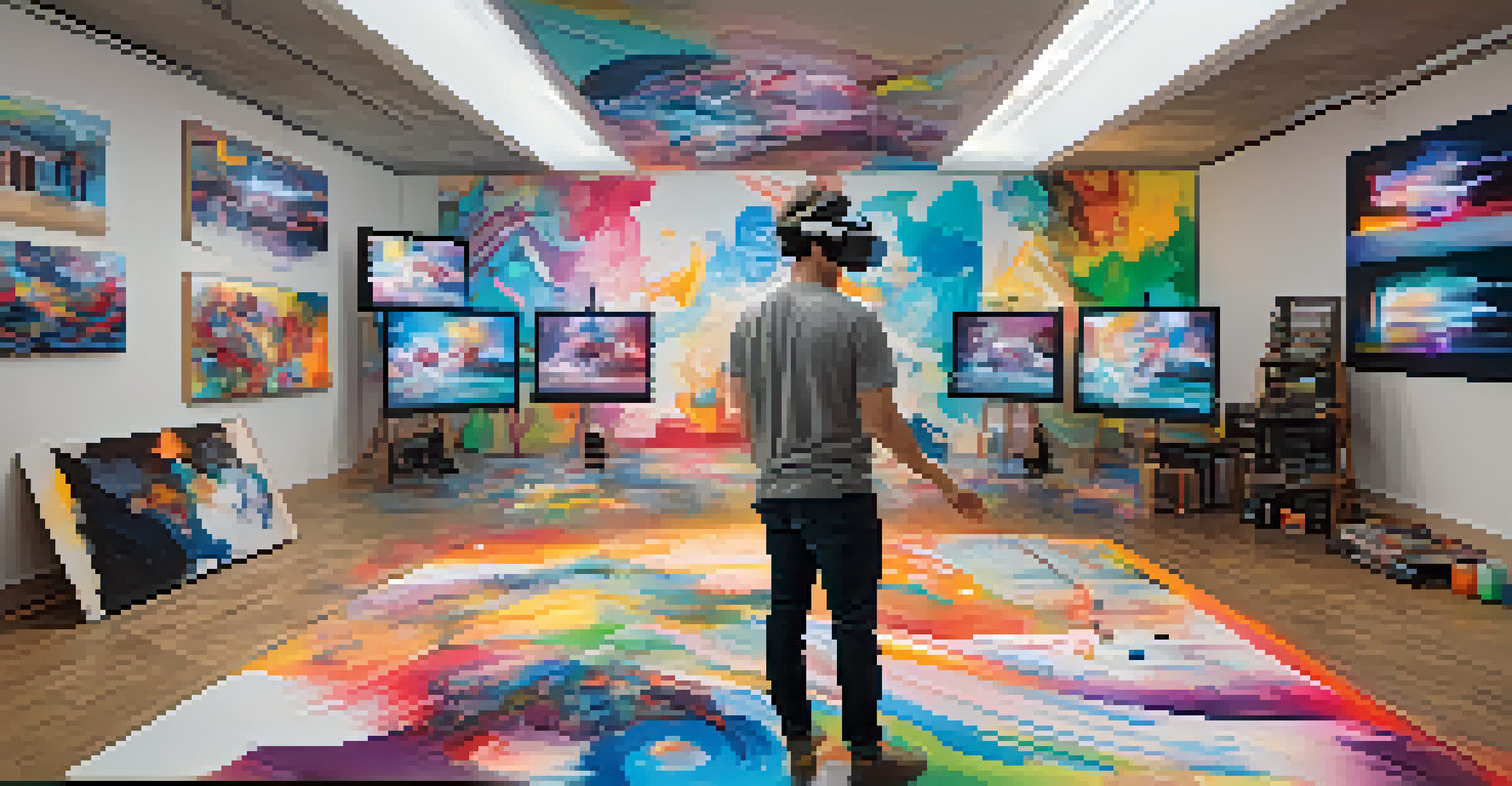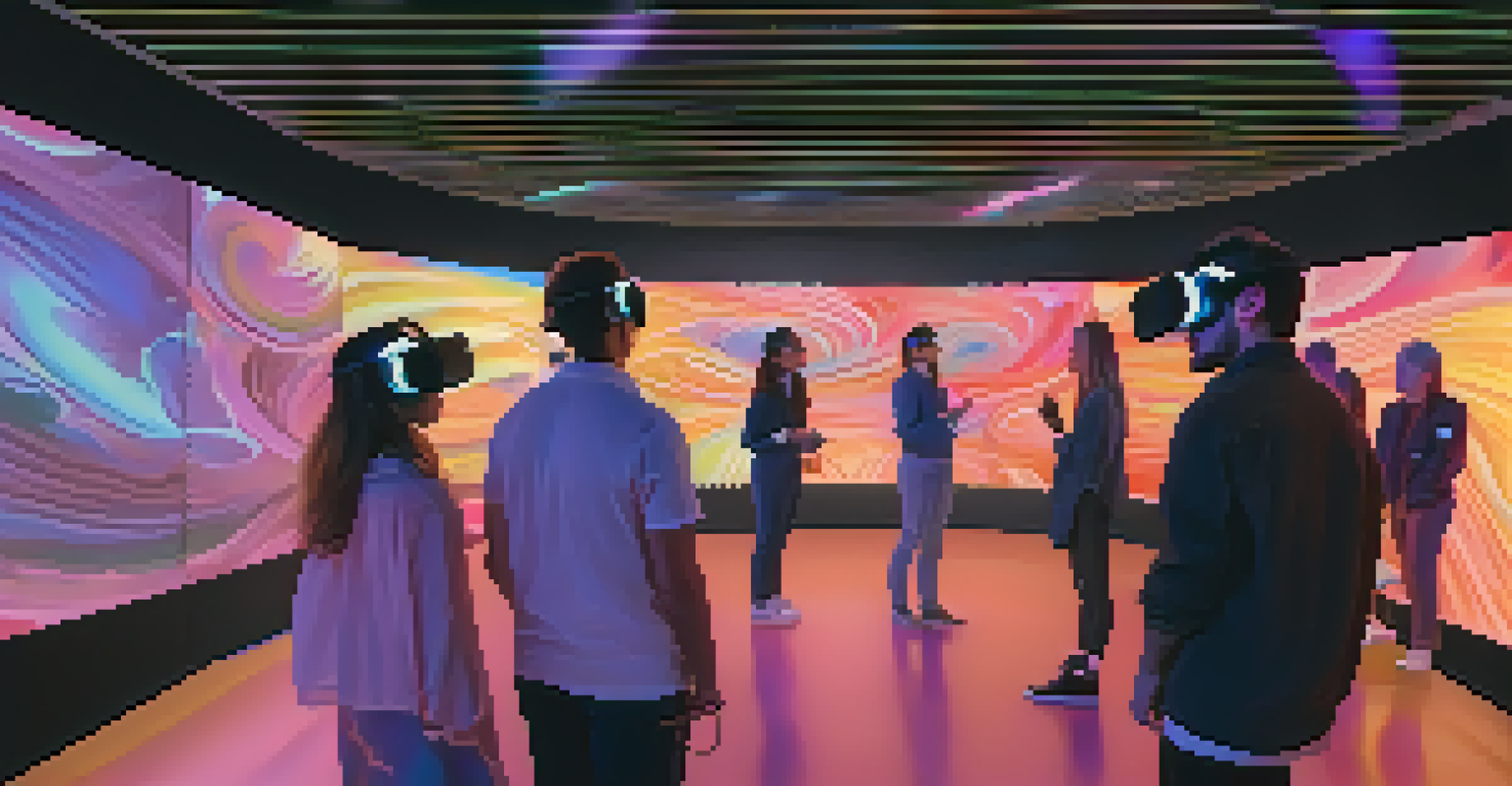Virtual Reality: A New Canvas for Contemporary Artists Today

Understanding Virtual Reality in the Art World
Virtual reality (VR) has emerged as an exciting new canvas for artists, allowing them to create immersive experiences that transcend traditional mediums. Unlike painting on a canvas or sculpting with clay, VR invites audiences to step into a 3D space, becoming part of the artwork itself. This dynamic interaction transforms passive viewing into active participation, fostering a deeper connection between the viewer and the artist's vision.
Virtual reality is not a new medium, but it is a new way of thinking about how we tell stories and interact with them.
The technology behind VR has evolved significantly, making it more accessible for artists to explore innovative concepts. With tools like Oculus Rift and HTC Vive, creators can design intricate environments and narratives that challenge the boundaries of imagination. As a result, VR art is not only visually stunning but also pushes the envelope of what art can represent in today's society.
Moreover, artists working in VR can experiment with elements like scale and perspective in ways that traditional art forms cannot. For instance, they might create a towering sculpture that envelops the viewer or a surreal landscape that shifts as one moves through it. This level of interactivity and immersion offers a fresh narrative style that captivates audiences and encourages them to see art through a new lens.
The Evolution of Artistic Expression through VR
Historically, artists have always embraced new technologies to expand their creative horizons. From the invention of photography to the rise of digital art, each innovation has shaped the way art is produced and experienced. VR represents the latest evolution, offering a unique platform that allows artists to explore themes of identity, reality, and perception in ways that were previously unimaginable.

For example, artists like Jon Rafman and Marina Abramović have taken advantage of VR to challenge viewers' perceptions of time and space. Rafman's immersive environments invite users to explore dreamlike landscapes, while Abramović uses VR to create provocative experiences that elicit emotional responses. These artists demonstrate how VR can serve as a powerful tool for social commentary and personal reflection.
VR Transforms Artistic Interaction
Virtual reality invites audiences to actively participate in art, forging deeper connections between viewers and artists.
As more artists experiment with VR, the medium continues to evolve, opening doors to new genres and styles that blend interactivity with storytelling. This evolution not only enriches the artistic landscape but also invites diverse voices and perspectives, making VR a vibrant space for contemporary expression.
How Artists are Using VR to Engage Audiences
In the realm of VR art, engagement is key. Artists are finding innovative ways to involve their audiences, encouraging them to engage with the artwork on a personal level. For instance, interactive installations allow viewers to influence the artwork's outcome, creating a unique experience for each individual. This level of participation makes art more relatable and memorable.
Art is not a thing; it is a way. It is a way of seeing, a way of being, a way of creating, a way of living.
Some artists are incorporating gamification elements into their VR projects, transforming the act of viewing art into an adventure. By allowing audiences to solve puzzles or navigate through intricate worlds, these artists create a sense of play that resonates with people of all ages. This playful approach not only enhances enjoyment but also fosters a deeper understanding of the themes being explored.
Additionally, the social aspect of VR cannot be overlooked. Artists are increasingly designing experiences that can be shared among multiple users, turning solitary experiences into communal ones. This shift not only broadens the reach of artistic expression but also cultivates a sense of community, making art more accessible to diverse audiences.
The Challenges Artists Face in the VR Space
While the potential of VR is immense, artists also encounter unique challenges as they navigate this new medium. One significant hurdle is the steep learning curve associated with VR technology. Artists may need to invest time in learning complex software and hardware tools, which can be daunting, especially for those accustomed to traditional art forms.
Moreover, creating immersive experiences requires a different mindset and approach to storytelling. Artists must consider how users will interact with their work and how to guide them through an experience that is both engaging and coherent. This shift in perspective can be challenging, as it demands a balance between artistic vision and user experience.
Challenges in VR Art Creation
Artists face a steep learning curve with VR technology and must adapt their storytelling methods to create engaging experiences.
Lastly, accessibility remains a concern in the VR art world. While technology has become more affordable, not everyone has access to VR equipment. This limitation can restrict the audience, making it crucial for artists and institutions to find ways to share their work beyond the confines of VR headsets. Exploring alternative platforms, such as 360-degree videos, can help bridge this gap.
The Role of Art Institutions in Supporting VR Artists
Art institutions play a vital role in promoting and supporting artists who venture into the VR space. By hosting exhibitions that showcase VR art, galleries can introduce this innovative medium to a wider audience. These exhibitions not only highlight the work of contemporary artists but also provide an opportunity for viewers to engage with VR in a supportive environment.
Furthermore, institutions can offer resources and training programs to help artists develop their skills in VR technology. Workshops and mentorship opportunities can empower artists to experiment with new techniques and concepts, fostering a culture of innovation within the artistic community. This support is essential for nurturing the next generation of VR artists.
In addition, collaborations between artists and institutions can lead to groundbreaking projects that push the boundaries of VR art. By pooling resources and expertise, these partnerships can create immersive experiences that captivate audiences and inspire future artistic endeavors. Together, artists and institutions can pave the way for a vibrant future in the world of VR.
The Future of VR in Contemporary Art
As technology continues to evolve, the future of VR in contemporary art looks promising. With advancements in hardware and software, artists will have access to even more powerful tools for creating immersive experiences. This technological evolution will likely lead to new artistic movements that challenge our perceptions of reality and art itself.
Moreover, VR has the potential to democratize art, making it accessible to people who may not have had the opportunity to engage with it in traditional settings. Virtual exhibitions can reach global audiences, transcending geographical barriers and fostering a more inclusive art world. This accessibility will allow diverse voices and stories to emerge, enriching the artistic landscape.
Support from Art Institutions
Art institutions play a crucial role in promoting VR art by providing resources, training, and exhibition opportunities for artists.
Ultimately, the intersection of art and technology will continue to inspire creativity and innovation. As artists embrace VR, they will pave the way for new forms of expression that reflect the complexities of our modern lives. This ongoing exploration will ensure that contemporary art remains dynamic, relevant, and deeply connected to the experiences of our time.
Conclusion: Embracing VR as a New Artistic Frontier
In conclusion, virtual reality has opened up exciting new possibilities for contemporary artists, allowing them to explore themes and narratives in immersive ways. This shift not only transforms how art is created but also how it is experienced by audiences, fostering deeper connections and engagement. As artists continue to experiment with VR, they challenge conventional norms and redefine what art can be.
While challenges exist, the support from art institutions and the growing accessibility of technology are paving the way for a vibrant future in VR art. This new medium encourages collaboration and innovation, inviting diverse voices to contribute to the ongoing conversation about contemporary art. By embracing VR, artists are not just creating new works; they are also shaping the future of artistic expression.

As we look ahead, it will be fascinating to see how this artistic frontier evolves and influences the broader art world. The possibilities are endless, and the journey into VR is just beginning. So, whether you're an artist or an art lover, it's time to step into this new realm and experience the magic of virtual reality art.